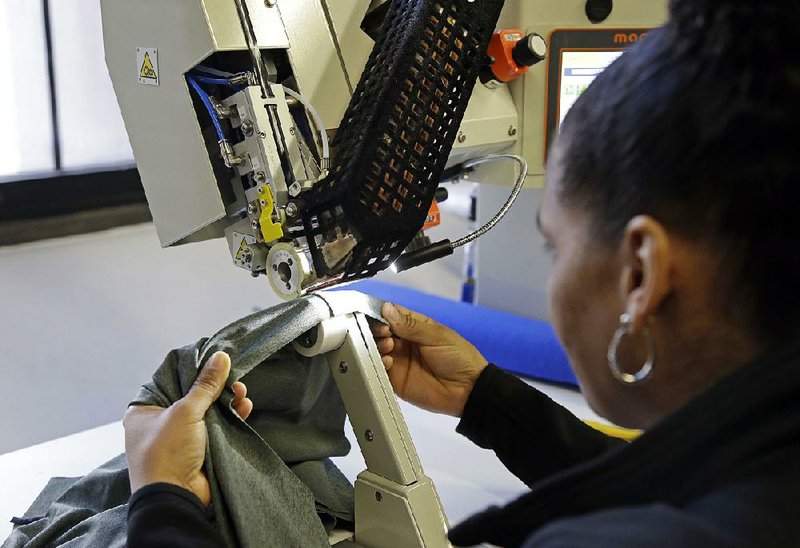WASHINGTON -- U.S. businesses added the most jobs in three years last month, a private survey found, a sign that hiring may be accelerating from last year's modest levels.
Payroll processor ADP said Wednesday that businesses added 298,000 jobs in February, up from 261,000 the previous month. The gains were led by an increase of 66,000 in construction jobs, the most in 11 years, and 32,000 manufacturing jobs, the most in five years.
The hiring boom in construction likely was driven by warm winter weather in much of the country. Construction sites typically shut down in winter.
"Unseasonably mild winter weather undoubtedly played a role. But near-record-high job openings and record-low layoffs underpin the entire job market," Mark Zandi, chief economist at Moody's Analytics Inc. in West Chester, Pa., said in a statement. Moody's produces the figures with ADP.
Job gains were broad-based and suggest that increased business optimism may have led to more hiring. January and February's job gains are above last year's average of about 185,000 per month.
"February proved to be an incredibly strong month for employment with increases we have not seen in years," said Ahu Yildirmaz, vice president and co-leader of the ADP Research Institute.
Measures of business confidence have jumped since the presidential election and the stock market has reached record highs in anticipation of President Donald Trump's promised tax cuts and deregulation. Investors are also optimistic with more evidence emerging of economic growth overseas, including Europe.
The ADP covers only private businesses and often diverges from official figures. Economists forecast that the government's jobs report, scheduled for release Friday, will show an increase of 186,000, according to data provider FactSet.
In recent months, after a change in ADP's methodology, its figures have gotten closer to the government's reported data. It was off just 9,000 in January and 8,000 the previous month.
Some economists are revising higher their forecasts for Friday's jobs report in the wake of the ADP figures. Ted Wieseman, an economist at Morgan Stanley, now expects job gains of 250,000, up from 200,000.
Other signs point toward a healthy job market, Wieseman said in an email. The number of people seeking unemployment benefits, a proxy for layoffs, has fallen to a 44-year low. And surveys of manufacturing and services firms in the past two months show greater interest in hiring.
The government's Friday report will be the final major economic data that Federal Reserve officials will see before their meeting next Tuesday and Wednesday, when they are widely expected to raise short-term interest rates for only the third time in nearly a decade.
A rate increase will be even more likely if the government's data reflect strong hiring similar to the ADP report. Many economists say job gains would have to plummet to roughly 50,000 or less to give the Fed pause.
The productivity of American workers grew at a slower pace in fourth quarter and last year recorded the smallest annual gain in five years.
The Labor Department said Wednesday that productivity grew at a 1.3 percent annual pace from October through December, down from 3.3 percent in the third quarter. For 2016, productivity eked out a 0.2 percent increase, the smallest since a 0.1 percent gain in 2011.
Labor costs, which account for changes in productivity, rose at a 1.7 percent annual pace in the fourth quarter. That's up from a 0.7 percent increase from July through September.
The fourth-quarter numbers were unchanged from an original report in February.
Gains in productivity have slowed in recent years for reasons economists are struggling to understand. Since 2007, productivity has grown by an average 1.2 percent a year, compared with an average 2.6 percent from 2000 through 2007 and 2.1 percent from 1947 through 2016.
Productivity measures output per hour worked. Increases are crucial for economic prosperity. When their workers are more productive, employers can afford to pay them more. And productivity gains, along with growth in the number of people working, determine how fast the economy grows.
The U.S. economy grew at a sluggish annual 1.9 pace from October through December, down sharply from 3.5 percent growth in the third quarter.
Trump vowed during the election campaign to double growth to 4 percent a year through tax cuts, deregulation and increased government spending on infrastructure and defense. Economists are skeptical he can reach that goal -- or even the target of 3 percent or better offered by Treasury Secretary Steven Mnuchin -- given the productivity slump and a slow-growing labor force.
Information for this article was contributed by Christopher S. Rugaber and Paul Wiseman of The Associated Press and by Patricia Laya of Bloomberg News.
Business on 03/09/2017
